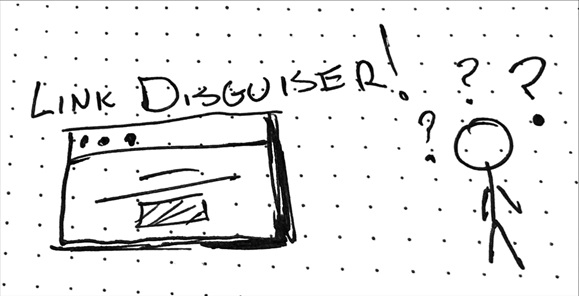Links, or URLs, are a core component of the web. A link consists of a URL - a Uniform Resource Locator - and some text to display to the user. A Link Disguiser Service is a service that offers several capabilities for working with links.
In this article, we will talk about what exactly is a Link Disguiser Service, how they work, who uses Link Disguiser Services, and what features you might find in a Link Disguiser Service.

A Link Disguiser service is a tool that modifies or obscures the URL of a hyperlink. For short, we often say 'link' instead of hyperlink.
From a user perspective, the user may see a link that says Click Here for more information! and
normally that link would have a URL of https://example.com/more-example-information. A link
disguiser service offers a redirection. So that URL would say, for example,
https://linkdisguiser.com?d=example-disguise.
The user still just sees a link that says Click Here for more information!, but their browser will
show a link that points to https://linkdisguiser.com?d=example-disguise. When the user clicks that
link, their browser makes a request to the Link Disguiser Service. When the service receives that request for
the page, it redirects the browser to visit the original URL
https://example.com/more-example-information.
From the perspective of the person who set up the disguised link, some information was recorded by the Link Disguiser Service, such as what time it was when the link was clicked.
Link Disguiser Services work by keeping memory of what disguises point to what URLs. When a request comes to the
Link Disguiser Service, it looks up in its database what URL that disguise should point to. Then, it returns an
HTTP code to the user's browser to redirect the call to that service, and records the click event in
its database.
Link Disguiser Services may offer many different features.
They may offer customizable links instead of automatically generated ones. For example,
https://linkdisguiser.com/ms-smiths-class to redirect to a teacher (Ms. Smith)'s classroom. When
that URL is passed around, users immediately know what might happen with the link because the URL is customized.
Link Disguiser Services may offer analytics, so that a user could know when a link got clicked, how often, geographic information, or what device was used to click a disguised link.
They may also provide security features that protect the server behind the original link. A Link Disguiser Service could refuse to redirect users that click multiple times, or refuse to redirect bots crawling the web.
They may offer features to expire a link, or limit the number of clicks that come through to the target server.
Analytics features are a popular feature of a Link Disguiser Service. As a social media manager, I may want to set up two disguised links that go to the same page on my company's website. I could put one link on Facebook, and another link on Instagram, and the Link Disguiser Service could tell me which link got more clicks.
A security professional may use Link Disguiser Services to perform white-hat phising attacks, testing users to make sure they don't click on malicious links.
Social Media users may use a Link Disguiser Service to make easy-to-read links for their followers to remember and click on later, or simply to make it past short character limits with a long URL.
There are several popular Link Disguiser Services:
Choosing which service to use will depend on your needs. If you are disguising a link to share on your personal social media page, any service will probably work fine. If you want powerful analytics features, you may want to consider a link disguiser that offers paid plans.
There are some problems to consider when using a Link Disguiser Service.
There are some privacy and trust issues to consider. Users may recognize a disguised link and believe that it is not trustworthy. Excessive use of disguised links may look suspicious in spam detectinon systems. Some users see a disguised URL and immediately think "this is something malicious!" and won't ever bother to click. Others may recognize them as "this link is a way to track me!" and avoid it.
There are also some technical problems to consider. A disguised link may not be aware that the target resource has moved, which could lead to broken links and a bad user experience. Using a Link Disguiser Service adds a dependency to your system. That is, if the Link Disguiser Service goes down, so do you links, even if the target URL is working just fine.
In summary, we talked about what is a Link Disguiser Service, how they work, who uses Link Disguiser Services, and what features you might find in a Link Disguiser Service.
A Link Disguiser Service can be used to make URLs across the web easier to read, provide digital media managers powerful analytics tools, and provide security analytics tools for training.
While Link Disguisers are a powerful tool for several use cases, but they are not without some risks, and consideration should be taken when using them.
Try out the features at LinkDisguiser.com today!